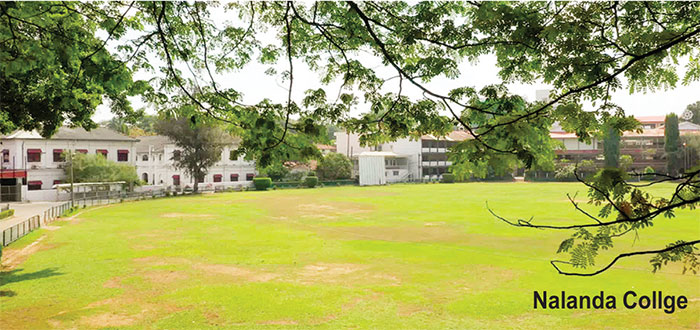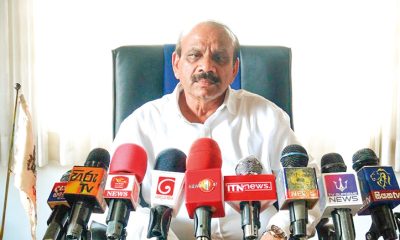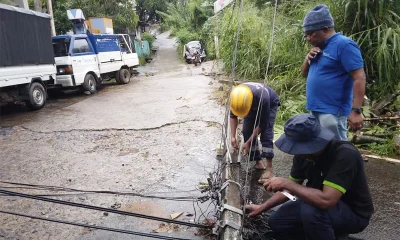Opinion
Sugunadasa Athukorale: Principal Par excellence

The month of November 2021 marks the 100th Birth anniversary of an Educationist par Excellence, Sugunadasa Athukorale, one of Nalanda’s greatest Principals who guided Nalanda’s destiny for 13 long years, from 1969 to 1982. Nalanda was going through a difficult time during the early 1960s due to various internal issues such as disagreements among staff members and no Principal could manage the situation which had gone out of control and even the students were getting involved in the disturbances. The Education Ministry appointed young Gunapala Wickramaratne as the Principal of Nalanda in 1964. Within a matter of weeks, he took control of the situation and instilled discipline and order in the school. Wickramaratne was able to turn around Nalanda in a short period and Nalanda became one of the best disciplined schools. But his stay was short, and he was promoted and transferred in 1969.
Mr. Athukorale, an Old Anandian, was serving as the Principal of Thakshila Vidyalaya, Horana, before his transfer to Nalanda. He was an extremely good Mathematics Teacher found his fiancée Hema also to be another good Mathematics teacher. She later taught Mathematics at Nalanda in the middle school, and became Mr. Athukrale’s life partner when she got married to him. His son Upul, who also studied at Nalanda is now domiciled in Canada, while his two daughters Gayathri and Savithri are living in Sri Lanka. Gayathri served in the tutorial staff of Nalanda as a teacher of Information Technology.
Mr. Athukorale was born in Keeranthidiya, in Matugama, on 12th November 1921 He had his education at Ananda College, Colombo. His administration skills were fine-tuned when he led the ‘Mathugama, Horawala Dodangoda Gam Sabawa’ as its head for two consecutive terms. He had relinquished his duties as the Head of the Gam Sabawa when the government took over the schools; he automatically became a state official.
 Mr. Athukorale by his actions, behavior and mannerisms set an example to the students, how one should have patience and tolerance, and how one should focus on one’s goals and work towards achieving it.
Mr. Athukorale by his actions, behavior and mannerisms set an example to the students, how one should have patience and tolerance, and how one should focus on one’s goals and work towards achieving it.
Mr. Athukorale’s integrity, honesty and simplicity was demonstrated in everything he did. He always worked for the greater good of the school. He wanted his students not only to reach national level but aim and achieve international levels. In order to give the best, he head hunted many a best teacher of the subject to Nalanda.
Mr. Athukorale always considered that it was the school’s responsibility to bring out the best in students. He encouraged freedom of expression among staff and students, promoted free thinking.
Mr. Athukorale had been a father, teacher and a friend to any student who sought his advice. Students who got caught for wrong doings were not punished initially but were severely warned and advised not to involve in such acts again. He always believed in giving students a second chance to correct themselves. He pushed students to achieve their full potential. During his time of service. Nalanda reached its peak in Academic performances, by improving the average number of students passing G.C.E (O/L) and (A/L) examinations, also producing the Island’s best students in science streams in certain years.
During his period, Nalanda reached the top in most of the sports and in, cricket, being the foremost and Nalanda had been consistently feeding players to the National team and the Sri Lanka schools cricket team. Hockey is another sport that continuously won championships at Inter school national level competitions. Athletics, too reached the top level with some record-breaking performances. Cadeting prospered and Senior Cadets won the coveted ‘Herman Loos’ Cup awarded to the best cadet platoon among the schools in the country twice. This trophy was won by Nalanda after 39 years. The Junior Cadets brought the “De Zoysa’ Challenge Trophy awarded to the Island’s best Junior Cadet Platoon after 12 years. Football too was another sport that reached top level.
Coinciding with the Golden Jubilee of Nalanda, the young past students of the school with the support, guidance and initiative, of the Principal Sugunadasa Athukorale formed the Nalanda Junior Old Boys Association (NJOBA) on the 7th of January 1975. The foresight the Principal had in supporting this initiative is evidenced today that this Association during its 47 years of journey has become one of the largest and wealthiest OBAs in the country.
Immediately after its formation, it began to support school in many ways. The very idea of forming this association was to get the young past students linked to the school at a very young age.
During his tenure, his mission was ‘not to be second to anyone’. He passed on this to teachers and students that “we don’t want to be first at the same time we don’t want to be second to anyone”. This message was made clear to every teacher and student, resulting in, a high demand for gaining admissions to Nalanda.
Mr. Athukorale had innovative approaches to solve problems and always encouraged creativity in students. It was always felt that he could see things 10 years ahead. His projects were futuristic. He saw the potential of Nalanda, to impart knowledge by giving a quality education to a higher number of students. He planned a rigorous programme of infrastructure development for Nalanda.
Mr. Athukorale should be credited for Nalanda’s rich infrastructure. A new three-storied Laboratory Building which has a Shrine Room an Auditorium and a Library was constructed during his era in 1979. He saw the need for a Theatre Hall to facilitate the development of performing skills and aesthetics of budding Nalandian artistes. A state-of-the-art Theatre Hall was constructed and it was named the ‘Malalasekera Hall ‘in honour of Nalanda’s First Principal Dr. Gunapala Malalasekera (1925-1927). These are some of the infrastructure projects this dynamic Principal added to the College.
His loyalty to Nalanda was unwavering till his death. Even after retirement he became a regular visitor to Nalanda and was available for any advice to many of us, past students. He was an honourable person with good human qualities. He spent a considerable time and effort to develop Nalanda. Very often he was seen after school hours watching sports practices at a corner of the College grounds under the shade of a tree. His life style was a very simple one. While he had his Volkswagen Beetle parked at school, he used to take the bus plying in route number 166 to go to the Education Department office at Green Path Colombo 2. He was spending public money very cautiously.
Mr. Athukorale preferred to be among his staff members and students. This was amply demonstrated at the first ever ‘Guru Upahara’ -Teacher felicitation ceremony organised by the Junior OBA in 1997, he enjoyed the company of his former lieutenants throughout the day and congratulated the Junior OBA for introducing such an event to the events calendar. I consulted him on many occasions for advice at the time I was heading Junior OBA. After his retirement, he participated in every event at Nalanda.
To coincide with the 100th birth Anniversary of this great Principal, Nalanda Junior Old Boys Association is organising the inaugural ‘Sugunadasa Athukorale Memorial Speech’ via zoom, which will be delivered by a prominent Old Nalandian during the month of November. This will be followed by a donation to the school. This programme will be added to the calendar of events of the Junior OBA. The Junior OBA is ever grateful to their founder patron Mr. Sugunadasa Athukorala. The name of Mr. Sugunadasa Athukorale will be written in gold in the history of Nalanda as one of the most far sighted Principals Nalanda ever had.
Athula Jayasekera
Past President (1995-1998)
Nalanda Junior OBA
Opinion
Lakshman Balasuriya – Not just my boss but a father and a brother

It is with profound sadness that we received the shocking news of untimely passing of our dear leader Lakshman Balasuriya.
I first met Lakshman Balasuriya in 1988 while working at John Keells, which had been awarded an IT contract to computerise Senkadagala Finance. Thereafter, in 1992, I joined the E. W. Balasuriya Group of Companies and Senkadagala Finance when the organisation decided to bring its computerisation in-house.
Lakshman Balasuriya obtained his BSc from the University of London and his MSc from the University of Lancaster. He was not only intellectually brilliant, but also a highly practical and pragmatic individual, often sitting beside me to share instructions and ideas, which I would then translate directly into the software through code.
My first major assignment was to computerise the printing press. At the time, the systems in place were outdated, and modernisation was a challenging task. However, with the guidance, strong support, and decisive leadership of our boss, we were able to successfully transform the printing press into a modern, state-of-the-art operation.
He was a farsighted visionary who understood the value and impact of information technology well ahead of his time. He possessed a deep knowledge of the subject, which was rare during those early years. For instance, in the 1990s, Balasuriya engaged a Canadian consultant to conduct a cybersecurity audit—an extraordinary initiative at a time when cybersecurity was scarcely spoken of and far from mainstream.
During that period, Senkadagala Finance’s head office was based in Kandy, with no branch network. When the decision was made to open the first branch in Colombo, our IT team faced the challenge of adapting the software to support branch operations. It was him who proposed the innovative idea of creating logical branches—a concept well ahead of its time in IT thinking. This simple yet powerful idea enabled the company to expand rapidly, allowing branches to be added seamlessly to the system. Today, after many upgrades and continuous modernisation, Senkadagala Finance operates over 400 locations across the country with real-time online connectivity—a testament to his original vision.
In September 2013, we faced a critical challenge with a key system that required the development of an entirely new solution. A proof of concept was prepared and reviewed by Lakshman Balasuriya, who gave the green light to proceed. During the development phase, he remained deeply involved, offering ideas, insights, and constructive feedback. Within just four months, the system was successfully developed and went live—another example of his hands-on leadership and unwavering support for innovation.
These are only a few examples among many of the IT initiatives that were encouraged, supported, and championed by him. Information technology has played a pivotal role in the growth and success of the E. W. Balasuriya Group of Companies, including Senkadagala Finance PLC, and much of that credit goes to his foresight, trust, and leadership.
On a deeply personal note, I was not only a witness to, but also a recipient of, the kindness, humility, and humanity of Lakshman Balasuriya. There were occasions when I lost my temper and made unreasonable demands, yet he always responded with firmness tempered by gentleness. He never lost his own composure, nor did he ever harbour grudges. He had the rare ability to recognise people’s shortcomings and genuinely tried to guide them toward self-improvement.
He was not merely our boss. To many of us, he was like a father and a brother.
I will miss him immensely. His passing has left a void that can never be filled. Of all the people I have known in my life, Mr. Lakshman Balasuriya stands apart as one of the finest human beings.
He leaves behind his beloved wife, Janine, his children Amanthi and Keshav, and the four grandchildren.
May he rest in eternal peace!
Timothy De Silva
(Information Systems Officer at Senkadagala Finance.)
Opinion
The science of love

A remarkable increase in marriage proposals in newspapers and the thriving matchmaking outfits in major cities indicate the difficulty in finding the perfect partners. Academics have done much research in interpersonal attraction or love. There was an era when young people were heavily influenced by romantic fiction. They learned how opposites attract and absence makes the heart grow fonder. There was, of course, an old adage: Out of sight out of mind.
Some people find it difficult to fall in love or they simply do not believe in love. They usually go for arranged marriages. Some of them think that love begins after marriage. There is an on-going debate whether love marriages are better than arranged marriages or vice versa. However, modern psychologists have shed some light on the science of love. By understanding it you might be able to find the ideal life partner.
To start with, do not believe that opposites attract. It is purely a myth. If you wish to fall in love, look for someone like you. You may not find them 100 per cent similar to you, but chances are that you will meet someone who is somewhat similar to you. We usually prefer partners who have similar backgrounds, interests, values and beliefs because they validate our own.
Common trait
It is a common trait that we gravitate towards those who are like us physically. The resemblance of spouses has been studied by scientists more than 100 years ago. According to them, physical resemblance is a key factor in falling in love. For instance, if you are a tall person, you are unlikely to fall in love with a short person. Similarly, overweight young people are attracted to similar types. As in everything in life, there may be exceptions. You may have seen some tall men in love with short women.
If you are interested in someone, declare your love in words or gestures. Some people have strong feelings about others but they never make them known. If you fancy someone, make it known. If you remain silent you will miss a great opportunity forever. In fact if someone loves you, you will feel good about yourself. Such feelings will strengthen love. If someone flatters you, be nice to them. It may be the beginning of a great love affair.
Some people like Romeo and Juliet fall in love at first sight. It has been scientifically confirmed that the longer a pair of prospective partners lock eyes upon their first meeting they are very likely to remain lovers. They say eyes have it. If you cannot stay without seeing your partner, you are in love! Whenever you meet your lover, look at their eyes with dilated pupils. Enlarged pupils signal intense arousal.
Body language
If you wish to fall in love, learn something about body language. There are many books written on the subject. The knowledge of body language will help you to understand non-verbal communication easily. It is quite obvious that lovers do not express their love in so many words. Women usually will not say ‘I love you’ except in films. They express their love tacitly with a shy smile or preening their hair in the presence of their lovers.
Allan Pease, author of The Definitive Guide to Body Language says, “What really turn men on are female submission gestures which include exposing vulnerable areas such as the wrists or neck.” Leg twine was something Princess Diana was good at. It involves crossing the legs hooking the upper leg’s foot behind the lower leg’s ankle. She was an expert in the art of love. Men have their own ways. In order to look more dominant than their partners they engage in crotch display with their thumbs hooked in pockets. Michael Jackson always did it.
If you are looking for a partner, be a good-looking guy. Dress well and behave sensibly. If your dress is unclean or crumpled, nobody will take any notice of you. According to sociologists, men usually prefer women with long hair and proper hip measurements. Similarly, women prefer taller and older men because they look nice and can be trusted to raise a family.
Proximity rule
You do not have to travel long distances to find your ideal partner. He or she may be living in your neighbourhood or working at the same office. The proximity rule ensures repeated exposure. Lovers should meet regularly in order to enrich their love. On most occasions we marry a girl or boy living next door. Never compare your partner with your favourite film star. Beauty lies in the eyes of the beholder. Therefore be content with your partner’s physical appearance. Each individual is unique. Never look for another Cleopatra or Romeo. Sometimes you may find that your neighbour’s wife is more beautiful than yours. On such occasions turn to the Bible which says, “Thou shalt not covet thy neighbour’s wife.”
There are many plain Janes and penniless men in society. How are they going to find their partners? If they are warm people, sociable, wise and popular, they too can find partners easily. Partners in a marriage need not be highly educated, but they must be intelligent enough to face life’s problems. Osho compared love to a river always flowing. The very movement is the life of the river. Once it stops it becomes stagnant. Then it is no longer a river. The very word river shows a process, the very sound of it gives you the feeling of movement.
Although we view love as a science today, it has been treated as an art in the past. In fact Erich Fromm wrote The Art of Loving. Science or art, love is a terrific feeling.
karunaratners@gmail.com
By R.S. Karunaratne
Opinion
Are we reading the sky wrong?

Rethinking climate prediction, disasters, and plantation economics in Sri Lanka
For decades, Sri Lanka has interpreted climate through a narrow lens. Rainfall totals, sunshine hours, and surface temperatures dominate forecasts, policy briefings, and disaster warnings. These indicators once served an agrarian island reasonably well. But in an era of intensifying extremes—flash floods, sudden landslides, prolonged dry spells within “normal” monsoons—the question can no longer be avoided: are we measuring the climate correctly, or merely measuring what is easiest to observe?
Across the world, climate science has quietly moved beyond a purely local view of weather. Researchers increasingly recognise that Earth’s climate system is not sealed off from the rest of the universe. Solar activity, upper-atmospheric dynamics, ocean–atmosphere coupling, and geomagnetic disturbances all influence how energy moves through the climate system. These forces do not create rain or drought by themselves, but they shape how weather behaves—its timing, intensity, and spatial concentration.
Sri Lanka’s forecasting framework, however, remains largely grounded in twentieth-century assumptions. It asks how much rain will fall, where it will fall, and over how many days. What it rarely asks is whether the rainfall will arrive as steady saturation or violent cloudbursts; whether soils are already at failure thresholds; or whether larger atmospheric energy patterns are priming the region for extremes. As a result, disasters are repeatedly described as “unexpected,” even when the conditions that produced them were slowly assembling.
This blind spot matters because Sri Lanka is unusually sensitive to climate volatility. The island sits at a crossroads of monsoon systems, bordered by the Indian Ocean and shaped by steep central highlands resting on deeply weathered soils. Its landscapes—especially in plantation regions—have been altered over centuries, reducing natural buffers against hydrological shock. In such a setting, small shifts in atmospheric behaviour can trigger outsized consequences. A few hours of intense rain can undo what months of average rainfall statistics suggest is “normal.”
Nowhere are these consequences more visible than in commercial perennial plantation agriculture. Tea, rubber, coconut, and spice crops are not annual ventures; they are long-term biological investments. A tea bush destroyed by a landslide cannot be replaced in a season. A rubber stand weakened by prolonged waterlogging or drought stress may take years to recover, if it recovers at all. Climate shocks therefore ripple through plantation economics long after floodwaters recede or drought declarations end.
From an investment perspective, this volatility directly undermines key financial metrics. Return on Investment (ROI) becomes unstable as yields fluctuate and recovery costs rise. Benefit–Cost Ratios (BCR) deteriorate when expenditures on drainage, replanting, disease control, and labour increase faster than output. Most critically, Internal Rates of Return (IRR) decline as cash flows become irregular and back-loaded, discouraging long-term capital and raising the cost of financing. Plantation agriculture begins to look less like a stable productive sector and more like a high-risk gamble.
The economic consequences do not stop at balance sheets. Plantation systems are labour-intensive by nature, and when financial margins tighten, wage pressure is the first stress point. Living wage commitments become framed as “unaffordable,” workdays are lost during climate disruptions, and productivity-linked wage models collapse under erratic output. In effect, climate misprediction translates into wage instability, quietly eroding livelihoods without ever appearing in meteorological reports.
This is not an argument for abandoning traditional climate indicators. Rainfall and sunshine still matter. But they are no longer sufficient on their own. Climate today is a system, not a statistic. It is shaped by interactions between the Sun, the atmosphere, the oceans, the land, and the ways humans have modified all three. Ignoring these interactions does not make them disappear; it simply shifts their costs onto farmers, workers, investors, and the public purse.
Sri Lanka’s repeated cycle of surprise disasters, post-event compensation, and stalled reform suggests a deeper problem than bad luck. It points to an outdated model of climate intelligence. Until forecasting frameworks expand beyond local rainfall totals to incorporate broader atmospheric and oceanic drivers—and until those insights are translated into agricultural and economic planning—plantation regions will remain exposed, and wage debates will remain disconnected from their true root causes.
The future of Sri Lanka’s plantations, and the dignity of the workforce that sustains them, depends on a simple shift in perspective: from measuring weather, to understanding systems. Climate is no longer just what falls from the sky. It is what moves through the universe, settles into soils, shapes returns on investment, and ultimately determines whether growth is shared or fragile.
The Way Forward
Sustaining plantation agriculture under today’s climate volatility demands an urgent policy reset. The government must mandate real-world investment appraisals—NPV, IRR, and BCR—through crop research institutes, replacing outdated historical assumptions with current climate, cost, and risk realities. Satellite-based, farm-specific real-time weather stations should be rapidly deployed across plantation regions and integrated with a central server at the Department of Meteorology, enabling precision forecasting, early warnings, and estate-level decision support. Globally proven-to-fail monocropping systems must be phased out through a time-bound transition, replacing them with diversified, mixed-root systems that combine deep-rooted and shallow-rooted species, improving soil structure, water buffering, slope stability, and resilience against prolonged droughts and extreme rainfall.
In parallel, a national plantation insurance framework, linked to green and climate-finance institutions and regulated by the Insurance Regulatory Commission, is essential to protect small and medium perennial growers from systemic climate risk. A Virtual Plantation Bank must be operationalized without delay to finance climate-resilient plantation designs, agroforestry transitions, and productivity gains aligned with national yield targets. The state should set minimum yield and profit benchmarks per hectare, formally recognize 10–50 acre growers as Proprietary Planters, and enable scale through long-term (up to 99-year) leases where state lands are sub-leased to proven operators. Finally, achieving a 4% GDP contribution from plantations requires making modern HRM practices mandatory across the sector, replacing outdated labour systems with people-centric, productivity-linked models that attract, retain, and fairly reward a skilled workforce—because sustainable competitive advantage begins with the right people.
by Dammike Kobbekaduwe
(www.vivonta.lk & www.planters.lk ✍️
-

 News7 days ago
News7 days agoBritish MP calls on Foreign Secretary to expand sanction package against ‘Sri Lankan war criminals’
-

 News6 days ago
News6 days agoStreet vendors banned from Kandy City
-

 Sports7 days ago
Sports7 days agoChief selector’s remarks disappointing says Mickey Arthur
-

 Opinion7 days ago
Opinion7 days agoDisasters do not destroy nations; the refusal to change does
-

 Sports3 days ago
Sports3 days agoGurusinha’s Boxing Day hundred celebrated in Melbourne
-

 News6 days ago
News6 days agoLankan aircrew fly daring UN Medevac in hostile conditions in Africa
-

 Sports4 days ago
Sports4 days agoTime to close the Dickwella chapter
-

 News20 hours ago
News20 hours agoLeading the Nation’s Connectivity Recovery Amid Unprecedented Challenges













